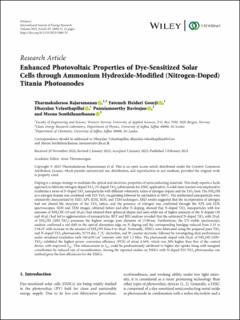| dc.contributor.author | Rajaramanan, Tharmakularasa | |
| dc.contributor.author | Fatemeh, Heidari Gourji | |
| dc.contributor.author | Velauthapillai, Dhayalan | |
| dc.contributor.author | Ravirajan, Punniamoorthy | |
| dc.contributor.author | Meena, S | |
| dc.date.accessioned | 2023-04-13T10:49:29Z | |
| dc.date.available | 2023-04-13T10:49:29Z | |
| dc.date.created | 2023-03-26T00:07:33Z | |
| dc.date.issued | 2023 | |
| dc.identifier.issn | 0363-907X | |
| dc.identifier.uri | https://hdl.handle.net/11250/3062859 | |
| dc.description.abstract | Doping is a unique strategy to modulate the optical and electronic properties of semiconducting materials. This study reports a facile approach to fabricate nitrogen-doped TiO2 (N-doped TiO2) photoanode for DSSC application. A solid-state reaction was employed to synthesize a series of N-doped TiO2 nanoparticles with different volumetric ratios of nitrogen dopant and the TiO2 host. The NH4OH as a nitrogen dopant was combined with P25-TiO2 via grinding followed by calcination at 500°C. The synthesized nanoparticles were extensively characterized by XRD, XPS, EDX, SEM, and TEM techniques. XRD results suggested that the incorporation of nitrogen had not altered the structure of the TiO2 lattice, and the presence of nitrogen was confirmed through the XPS and EDX spectroscopies. SEM and TEM images, obtained before and after N doping, showed that N-doped TiO2 nanoparticles with low amounts of NH4OH (10 and 20 μL) had retained their spherical shapes and sizes while use of higher amounts of the N dopant (30 and 40 μL) had led to agglomeration of nanoparticles. BET and BJH analyses revealed that the optimized N-doped TiO2 with 20 μL of NH4OH (20N-TiO2) possesses the highest average pore diameter of 15.99 nm. Furthermore, the UV-visible spectroscopic analysis confirmed a red shift in the optical absorption edge on N doping and the corresponding bandgap reduced from 3.15 to 2.94 eV with increase in the amount of NH4OH from 0 to 40 μL. Eventually, DSSCs were fabricated using the prepared pure TiO2 and N-doped TiO2 photoanodes, N719 dye, I−/I−3 electrolyte, and Pt counter electrode, followed by investigating their performance under simulated irradiation with 100 mW/cm2 intensity with AM 1.5 filter. The photoanode doped with 20 μL of NH4OH (20N-TiO2) exhibited the highest power conversion efficiency (PCE) of about 6.16%, which was 20% higher than that of the control device, with improved JSC. This enhancement in JSC could be predominantly attributed to higher dye uptake along with marginal contribution by reduced rate of recombination. Among the reported studies on DSSCs with N-doped P25-TiO2 photoanodes, our method gives the best efficiencies for the DSSCs. | en_US |
| dc.language.iso | eng | en_US |
| dc.publisher | Wiley | en_US |
| dc.rights | Navngivelse 4.0 Internasjonal | * |
| dc.rights.uri | http://creativecommons.org/licenses/by/4.0/deed.no | * |
| dc.title | Enhanced Photovoltaic Properties of Dye-Sensitized Solar Cells through Ammonium Hydroxide-Modified (Nitrogen-Doped) Titania Photoanodes | en_US |
| dc.type | Peer reviewed | en_US |
| dc.type | Journal article | en_US |
| dc.description.version | publishedVersion | en_US |
| dc.rights.holder | Copyright © 2023 Tharmakularasa Rajaramanan et al. | en_US |
| dc.source.volume | 2023 | en_US |
| dc.source.journal | International Journal of Energy Research | en_US |
| dc.identifier.doi | https://doi.org/10.1155/2023/1090174 | |
| dc.identifier.cristin | 2136936 | |
| dc.relation.project | Direktoratet for internasjonalisering og kvalitetsutvikling i høgare utdanning: UTF-2020/10053 | en_US |
| cristin.ispublished | true | |
| cristin.fulltext | original | |
| cristin.qualitycode | 1 | |

